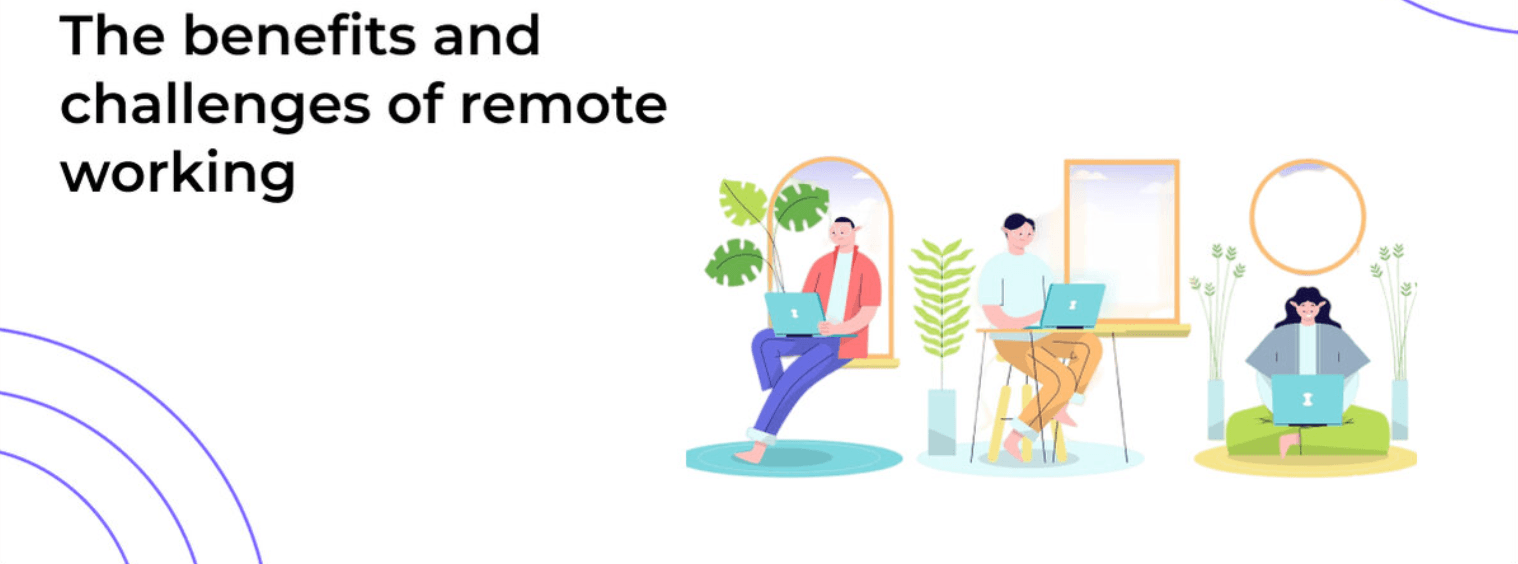The global workplace has completely changed as a result of remote work, which provides businesses and people with previously unheard-of freedom and opportunity. Although working remotely has many benefits, certain issues must be resolved to maintain well-being and productivity. This in-depth essay examines the many advantages and difficulties of working remotely, offering advice and solutions for both corporations and remote employees.
Reports suggest a “turnover tsunami” or “great resignation” is predicted when pandemic restrictions ease. In 2021, 52% of North American workers are looking for new jobs, a 43% increase from 2019. Work environment preference, pandemic burnout, and compensation goals are major factors driving job-change plans. Remote work offers flexibility and productivity while returning to the office avoids productivity pressure. Organizations must consider how this redefinition will shape career choices and take measures to retain employees, keep them engaged, and prevent burnout.
The Evolution of Remote Work
Between 2019 and 2023, the number of Americans working remotely increased fivefold, with 40% of workers doing so at least one day each week. The model has a crucial impact on remote work productivity. Compared to totally in-person work, fully remote work is associated with 10% poorer productivity. Remote communication difficulties, mentorship obstacles, culture development challenges, and self-motivation problems seem to be contributing causes. However, companies are finding that entirely remote work can result in even greater cost savings due to space savings and international recruiting. Although hybrid working doesn’t seem to affect productivity, businesses like it since it helps with hiring and staff retention.

Going forward, the rise in research and development into new technologies to enhance remote working will contribute to the growth of working from home. As a result, the pandemic caused a spike in the number of people working from home and a longer-term growth acceleration.
Benefits of Remote Work
Recent years have seen a rise in the popularity of remote work, with many companies now providing their staff with the option to work from home. Employees who work remotely may reap several advantages, including higher output, more flexibility, and the ability to pursue other career paths. Managing home distractions, missing out on in-person interactions with coworkers, and being more prone to burnout are common issues that come with working remotely.
Accessibility to Economic Opportunity
The fact that working remotely makes more economic prospects accessible is one of its main benefits. For those who have traditionally been left out of the digital economy, such as caretakers, people with disabilities, residents of rural communities, and people who have mobility or immobility challenges, this is especially revolutionary.

These people may now access a greater variety of job possibilities without needing to be physically present thanks to the many forms of remote work, which removes the logistical and geographic constraints that once prevented them from participating in the workforce.
Through greater labor participation and productivity, this democratization of job access may result in a more varied and inclusive workplace, supporting not just individual livelihoods but also the economy as a whole.
You have more flexibility
You may usually modify your schedule to fit your demands when working from home. This might be the flexibility you need to make work work for you if you know you can squeeze in some early morning work that will then allow you the room and time to take care of an elderly relative or drop your child off at school.

Working remotely may be very beneficial for those with impairments, especially those who suffer from neurodiverse disorders like attention deficit hyperactivity disorder (ADHD) and autism. People with special needs can work in a way that suits them best because of the extra flexibility and independence that remote work usually affords.
Better work-life balance
A heavy workload can decrease productivity, leading to errors and mistakes. To boost productivity, take time for rest and personal activities. Use project schedule templates to organize tasks and schedules. Reduce burnout by balancing work and personal life responsibilities. Improve wellness by allowing rest, relaxation, and time with loved ones. A healthy work-life balance can lead to a happier work environment, reducing employee turnover by 25%. Encouraging employees to respect their personal lives increases their retention.

To maintain health and energy, people need variety in work-life balance. Overworking can lead to burnout, fatigue, and stress-related health issues. Poor work-life balance can result in employees working more hours but being less productive, highlighting the importance of a diverse range of activities and rest.
Enhanced Opportunities for Continuous Learning and Skill Development
Working remotely naturally requires you to become acquainted with a variety of digital tools and online platforms, which unintentionally improves your digital fluency—a highly valued talent in today’s industry. Beyond this, there are many of chances for further education and career advancement in the remote work environment.

Accessible tools such as online courses, webinars, virtual conferences, and industry-specific forums enable remote workers to remain up to date with changing industry trends, improve their current remote skill sets, and even explore new areas of knowledge. Most notably, self-paced study is made possible by the ease of online learning, which helps workers successfully reconcile employment and professional development obligations.
Moreover, remote work frequently fosters a culture of self-directed learning by motivating people to actively seek out information, hone their problem-solving abilities, and engage in deep work, all of which support a growth mindset and ongoing team progress.
Environmental Impact
image of a house surrounded by lush vegetation with a cityscape in the distance, divided in two: the left half is colorful and has a hopeful-looking sky, while the right side is gray and white.
Working remotely can benefit the environment in addition to saving money. According to research published in the Proceedings of the National Academy of Sciences USA, working from home instead of on-site can cut your carbon footprint at work by up to 58%. This is mostly because commuting trips and the greenhouse gas emissions they cause have been eliminated.

Additionally, since fewer workers are present in offices, less power is needed for temperature control and lighting, which lowers energy usage there as well. The aforementioned report also points out that, among other reasons, remote workers may need more space for an office, which can lead to a higher carbon footprint.
Still, research out to date indicates that businesses may help create a more environmentally friendly workplace by adopting remote work policies.
Exposure to Diverse Perspectives and Cultures
screen featuring individuals from many civilizations with flags in the backdrop People are exposed to new methods of thinking, working, and communicating since remote teams frequently span many locations, time zones, and even nations. This variety offers a more comprehensive worldwide view of a range of challenges and can encourage creativity, ingenuity, and empathy within the team.

Furthermore, working remotely frequently permits a higher level of cultural sensitivity and knowledge. People become more sensitive to cultural quirks, traditions, and communication styles when they interact and work with coworkers from other backgrounds. This fosters inclusive and harmonious team dynamics.
Overall, this improves team culture while also giving people the opportunity to further their general worldview and interpersonal skills.
Challenges of Remote Work
The modern work world is dominated by remote and hybrid operations, offering flexibility and convenience to companies. However, these options also present challenges such as collaboration, productivity, project management, and security. To ensure these advantages are not liabilities, owners and managers must navigate these challenges and create a thriving work environment that fosters growth, productivity, and positive communication.
Remote team collaboration and communication
The most important and difficult part of working remotely might be collaborating and communicating. Since there is less in-person connection and more technological communication available, building strong, fruitful relationships with coworkers requires more effort.
People must identify the individuals within their business and understand the procedures for resolving problems at the same time. Because onboarding requires more mental effort than in-office employment or co-working locations, it is particularly challenging. It creates a lot of difficulties for supervisors who operate remotely.

This implies that proper onboarding requires concentration and deliberate effort. Companies could use virtual meetings, conference calls, team-building exercises, and knowledge management systems to make it easier for employees to communicate when working outside of the typical workspace.
It’s challenging to get people to discuss or solve problems together. Rather, begin by dismantling the obstacles to cooperation. Your remote team will feel more at ease working together once the obstacles are removed. You may even learn to handle asynchronous work and have expanded coverage operating across several time zones after you overcome communication gaps.
Productivity
When working from home, it might be difficult to maintain productivity. Teams frequently switch to asynchronous work due to a variety of factors, including time management difficulties, lack of supervision, and distractions.
Remote organizations must have explicit objectives, metrics, and assessment procedures. Employ time management technologies, particularly those that interact with Hubstaff time monitoring, such as Insights, to help employees stay on task.

Here, shifting from sheer hours to tasks and goals is critical. Reaching objectives is given priority by productive remote workers. This is more accurately assessed and achieved when individuals are judged on the accomplishment of tasks rather than merely the amount of time spent in front of a computer.
People are encouraged to be more productive when objectives and KPIs are driven by outcomes rather than by erroneous metrics and measures, which can cause annoyance or disengagement.
Overworking and stress
In remote work environments, overworking is common. Distinguishing work from home life may be difficult when there is no clear demarcation. Companies should set fair and realistic timelines to overcome this difficulty. We want to revisit the premise that organizations stand to gain from reorienting their aims from hourly labor to results.

Tracking hours is still necessary to be paid. But rather than utilizing only productivity measures that measure keystrokes or keyboard activity, people’s work should be evaluated based on their accomplishments. Instead, take advantage of those activity components to confirm work activity and identify patterns to propel your team to new heights.
Burnout is a serious risk and is difficult to identify, particularly for managers who are new to remote work or leadership. Here are some warning indicators to look out for along with advice on how to precisely handle them.
Time zone differences
Speaking of timeframes, physical location and time provide another difficulty for businesses when it comes to remote labor. Despite its apparent simplicity, this might be one of the most difficult remote work tasks for managers. Working with multinational teams is a big challenge due to time zone variations. Even though people may be in the same state or nation, working remotely might make things more difficult because you’ll have to manage multiple time zones.

If your organization encourages more asynchronous work, think about selecting and informing team members about the corporate time zone. It will be simpler to arrange meetings that everyone can attend in this way.
Fortunately, a lot of programs, such as Google Calendar, can translate deadlines and meetings into local time. Because of this, a manager may designate a particular time, and everyone will be aware of it. The possibility of time zone conversion problems is eliminated by automated technologies.
Numerous advantages come with working remotely, such as more flexibility, higher output, lower costs, access to a worldwide talent pool, less of an impact on the environment, and happier workers. It also brings with it difficulties with communication, preserving work-life balance, isolation, complex management, hazards with data security, and technological obstacles.
Through the application of efficient tactics and industry best practices, people and businesses may optimize the advantages of working remotely while minimizing its drawbacks. Successful remote work requires prioritizing communication, establishing clear guidelines, cultivating a great work environment, promoting employee well-being, improving cybersecurity, and making technological investments.
Businesses and workers must innovate and adapt as remote work continues to change to provide a healthy and productive work environment. Future work environments that are more adaptable, inclusive, and sustainable can result from remote work if done properly.








